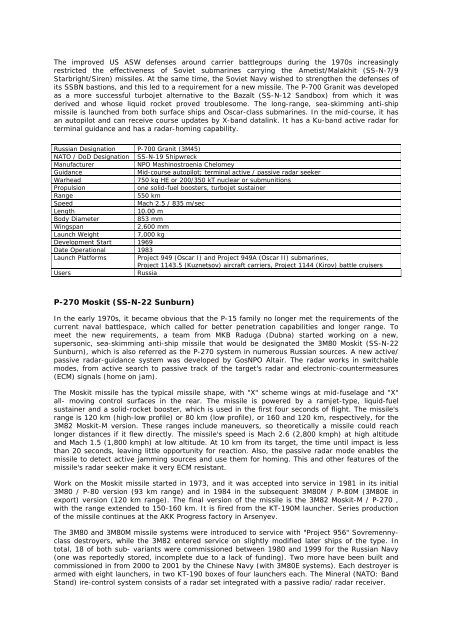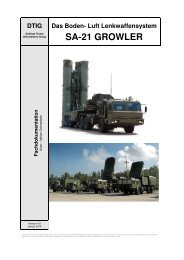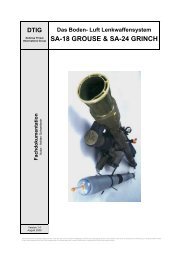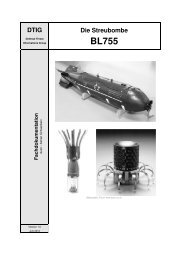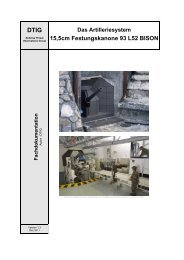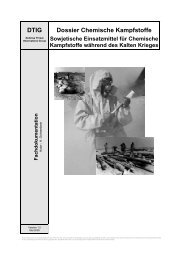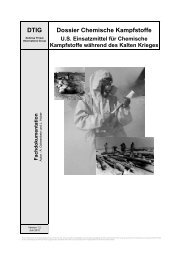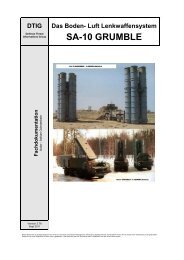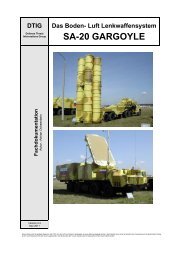RUSSIAN/SOVIET SEA-BASED ANTI-SHIP MISSILES Specia ... - DTIG
RUSSIAN/SOVIET SEA-BASED ANTI-SHIP MISSILES Specia ... - DTIG
RUSSIAN/SOVIET SEA-BASED ANTI-SHIP MISSILES Specia ... - DTIG
You also want an ePaper? Increase the reach of your titles
YUMPU automatically turns print PDFs into web optimized ePapers that Google loves.
The improved US ASW defenses around carrier battlegroups during the 1970s increasingly<br />
restricted the effectiveness of Soviet submarines carrying the Ametist/Malakhit (SS-N-7/9<br />
Starbright/Siren) missiles. At the same time, the Soviet Navy wished to strengthen the defenses of<br />
its SSBN bastions, and this led to a requirement for a new missile. The P-700 Granit was developed<br />
as a more successful turbojet alternative to the Bazalt (SS-N-12 Sandbox) from which it was<br />
derived and whose liquid rocket proved troublesome. The long-range, sea-skimming anti-ship<br />
missile is launched from both surface ships and Oscar-class submarines. In the mid-course, it has<br />
an autopilot and can receive course updates by X-band datalink. It has a Ku-band active radar for<br />
terminal guidance and has a radar-homing capability.<br />
Russian Designation P-700 Granit (3M45)<br />
NATO / DoD Designation SS-N-19 Shipwreck<br />
Manufacturer NPO Mashinostroenia Chelomey<br />
Guidance Mid-course autopilot; terminal active / passive radar seeker<br />
Warhead 750 kg HE or 200/350 kT nuclear or submunitions<br />
Propulsion one solid-fuel boosters, turbojet sustainer<br />
Range 550 km<br />
Speed Mach 2.5 / 835 m/sec<br />
Length 10.00 m<br />
Body Diameter 853 mm<br />
Wingspan 2,600 mm<br />
Launch Weight 7,000 kg<br />
Development Start 1969<br />
Date Operational 1983<br />
Launch Platforms Project 949 (Oscar I) and Project 949A (Oscar II) submarines,<br />
Project 1143.5 (Kuznetsov) aircraft carriers, Project 1144 (Kirov) battle cruisers<br />
Users Russia<br />
P-270 Moskit (SS-N-22 Sunburn)<br />
In the early 1970s, it became obvious that the P-15 family no longer met the requirements of the<br />
current naval battlespace, which called for better penetration capabilities and longer range. To<br />
meet the new requirements, a team from MKB Raduga (Dubna) started working on a new,<br />
supersonic, sea-skimming anti-ship missile that would be designated the 3M80 Moskit (SS-N-22<br />
Sunburn), which is also referred as the P-270 system in numerous Russian sources. A new active/<br />
passive radar-guidance system was developed by GosNPO Altair. The radar works in switchable<br />
modes, from active search to passive track of the target's radar and electronic-countermeasures<br />
(ECM) signals (home on jam).<br />
The Moskit missile has the typical missile shape, with "X" scheme wings at mid-fuselage and "X"<br />
all- moving control surfaces in the rear. The missile is powered by a ramjet-type, liquid-fuel<br />
sustainer and a solid-rocket booster, which is used in the first four seconds of flight. The missile's<br />
range is 120 km (high-low profile) or 80 km (low profile), or 160 and 120 km, respectively, for the<br />
3M82 Moskit-M version. These ranges include maneuvers, so theoretically a missile could reach<br />
longer distances if it flew directly. The missile's speed is Mach 2.6 (2,800 kmph) at high altitude<br />
and Mach 1.5 (1,800 kmph) at low altitude. At 10 km from its target, the time until impact is less<br />
than 20 seconds, leaving little opportunity for reaction. Also, the passive radar mode enables the<br />
missile to detect active jamming sources and use them for homing. This and other features of the<br />
missile's radar seeker make it very ECM resistant.<br />
Work on the Moskit missile started in 1973, and it was accepted into service in 1981 in its initial<br />
3M80 / P-80 version (93 km range) and in 1984 in the subsequent 3M80M / P-80M (3M80E in<br />
export) version (120 km range). The final version of the missile is the 3M82 Moskit-M / P-270 ,<br />
with the range extended to 150-160 km. It is fired from the KT-190M launcher. Series production<br />
of the missile continues at the AKK Progress factory in Arsenyev.<br />
The 3M80 and 3M80M missile systems were introduced to service with "Project 956" Sovremennyclass<br />
destroyers, while the 3M82 entered service on slightly modified later ships of the type. In<br />
total, 18 of both sub- variants were commissioned between 1980 and 1999 for the Russian Navy<br />
(one was reportedly stored, incomplete due to a lack of funding). Two more have been built and<br />
commissioned in from 2000 to 2001 by the Chinese Navy (with 3M80E systems). Each destroyer is<br />
armed with eight launchers, in two KT-190 boxes of four launchers each. The Mineral (NATO: Band<br />
Stand) ire-control system consists of a radar set integrated with a passive radio/ radar receiver.


